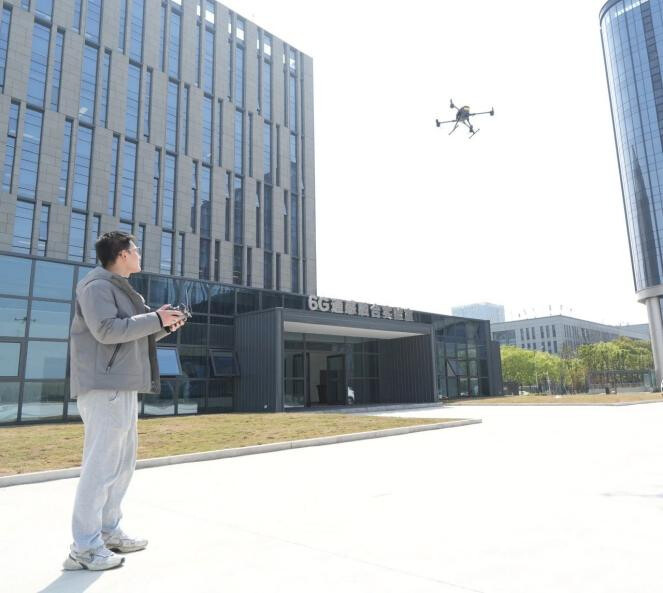By Yao Xueqing, People’s Daily
With a soft hum, a drone carrying a box of medicine lifted off from a pharmacy on Tianyuan West Road in Jiangning district, Nanjing, east China’s Jiangsu province. Guided by its operator, it flew eight kilometers and landed smoothly at the east gate of the Purple Mountain Laboratories, a major scitech innovation platform focusing on basic and frontier research on the internet. .
This rapid, sustained, and stable flight exemplifies the application of 6G technology in advancing smart city development and the burgeoning low-altitude economy.
6G, the sixth generation of mobile communication technology, distinguishes itself from predecessors most notably in speed. A widely cited analogy illustrates this progression: if 2G resembles an oxcart, 3G a bicycle, 4G a car, and 5G a high-speed train, 6G would equate to an airplane.
According to Huang Yongming, director of the Pervasive Communication Research Center at Purple Mountain Laboratories, the first generation of mobile communications relied on a “cellular” network architecture.In this system, base stations transmit signals to terminals within a designated coverage zones,- termed”cells” – which are typically hexagonal, giving rise to the concept of “cellular communication.”While later generations improved performance, the foundational cellular structure persisted.
In 2018, when Purple Mountain Laboratories was founded, You Xiaohu, an academician of the Chinese Academy of Sciences, and his team embarked on a groundbreaking mission:developing cell-free radio access network technology.
“This innovation dismantles traditional cell boundaries by synchronizing and centrally processing all information.The outcome is enhanced signal strength and coverage extended over tenfold compared to conventional cellular networks,” explained Wang Dongming, a professor at the Pervasive Communication Research Center.
For example, a delivery drone traveling eight kilometers under a 5G network would traverse nearly 20 distinct cells, requiring repeated signal handovers at each boundary. Such frequent transitions heighten disconnection risks, potentially forcing the drone to abort its mission.A cell-free network effectively resolves this challenge.
6G’s advantages extend far beyond speed.
Above the vast waters of Taihu Lakenear Xishan Island, adrone hovered in flight, conducting a 33-kilometer aerial inspection of fishery resources. Equipped with a high-definition night vision camera, infrared sensors, and custom-developed smart applications, the drone was operated autonomously – capable of taking off, landing, recharging, and 24/7 task execution – allpowered by a single base station on the island.
Last year, Purple Mountain Laboratories partnered with China Unicom and the Taihu Fishery Management Committee Officeto trial ultra-long-range cell-free communication at a lake-basedfishery conservation area. “A single station provides ten times the coverage of 5G,”explained Liu Dongjie, the project’s technical lead.
By transcending the limitations of terrestrial base stations, 6G enables seamless integrated communication across land, sea, air, and space. It also unifies communication, sensing, computing, and artificial intelligence into a cohesive system.
In January this year, Purple Mountain Laboratories collaborated with China Railway Signal & Communication Co., Ltd to conduct a “One Tower, One City” low-altitude communication test in Nujiang Lisu autonomous prefecture in southwest China’s Yunnan province.
By installing cell-free base stations on elevated infrastructure, they enabled drone-assisted forest fire monitoring, addressing persistent challenges such as exorbitant infrastructure costs and weak signal coverage in mountainous regions.
Meanwhile, along a road section between Mozhou East Road and Yougu Road in Jiangning district, three autonomous street-sweeping vehicles operated across a 21,000-square-meter area.Following predefined routes, these vehicles utilized high-definition cameras, LiDARs, and multi-sensor arrays to detect obstacles and pinpoint debris with precision.
“Thecell-freenetwork,transmits images from the sweepers to a control center, where data isprocessedand commandsare issued – all within milliseconds,” explained 6G engineer Jiang Tianxiang. The network’s stable performance and deterministic latency ensure rapid, accurate responses from the vehicles.
Globally, 6G development is transitioning from theoretical research to overcoming core technical challenges. Priorities have expanded beyond isolated technological breakthroughs to establishing a cohesive industrial ecosystem.
Experts designate 2025 as the “inaugural year of 6G standardization,”with standardization efforts projected to conclude by 2029 and preliminary commercial deployment anticipated around 2030.
“Looking ahead, 6G has great potential to revolutionize manufacturing,” said Huang. Among the many use cases, embodied intelligencestands out as a particularly transformative use case..
“Leveraging 6G’s ultra-high-speed connectivity and deterministic latency, industrial robots will achieve unprecedented agility and precision in executing intricate, high-skill operations. Future intelligent robots may even collaborate with other autonomous systems via 6G networks to accomplish complex missions,” Huang elaborated.
